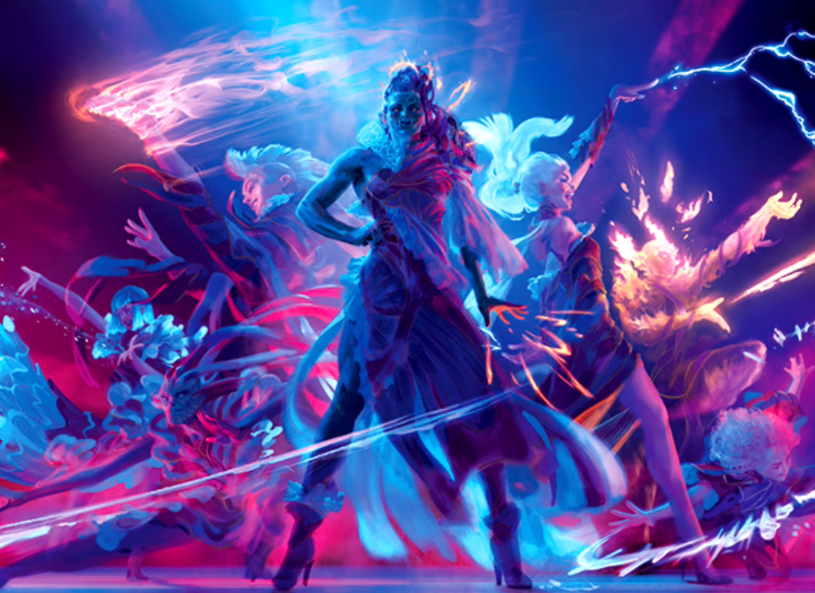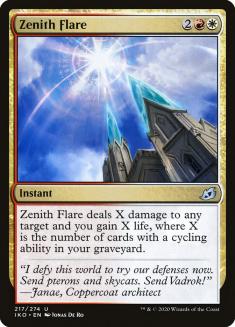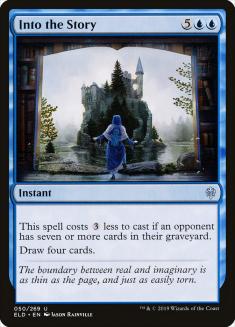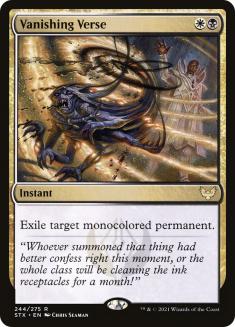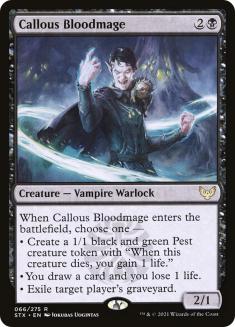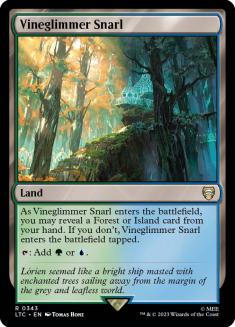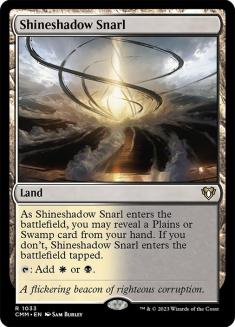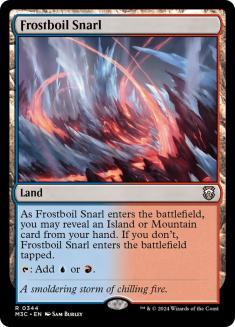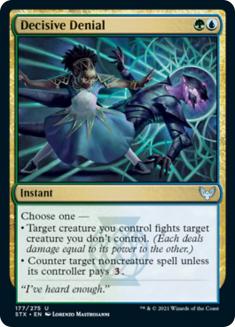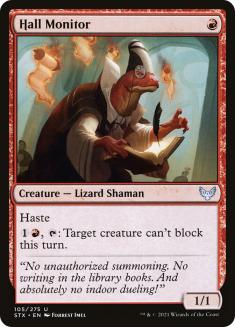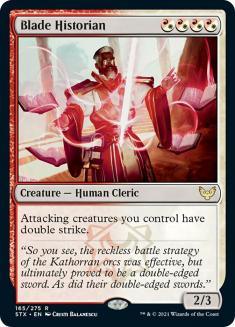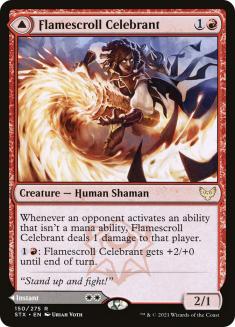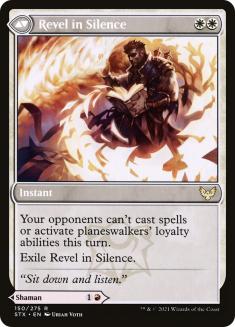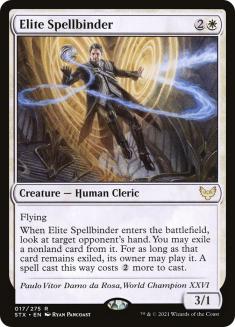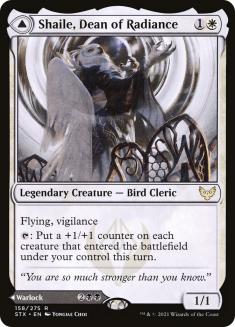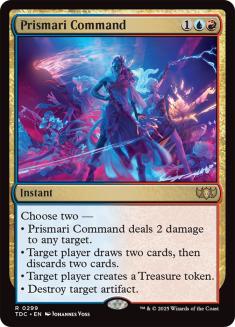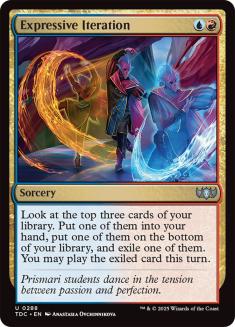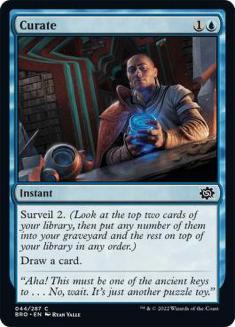It’s hard to judge the exact impact that Strixhaven will have in Standard. This is mostly for two reasons:
- The set is not very powerful, and the previous sets were, so there aren’t many cards who can shake everything up.
- A lot of the current Standard decks are very parasitic and limited in what they can add.
Take, for example, Jeskai Cycling. That deck is just very unlikely to gain a new card, at least in the maindeck, because every card either has cycling or is a payoff of some sort. Dimir Rogues (Lurrus) is similar. You have the enablers (the Rogues) and the payoffs (Into the Story, Drown in the Loch), so there’s not much room for any new card unless you happen to be upgrading a removal spell into something slightly better.
The fact that some of these decks have companions also makes adding new cards harder. Lurrus of the Dream-Den is such an integral part of Dimir Rogues that it makes it hard to consider any card that doesn’t fit its criteria, so at that point we’re looking at even fewer potential new additions.
Still, there are some decks that will likely find some improvements in Strixhaven. Here are the currently good Standard decks that I think can be improved:
1. Four-Color Blink (Yorion)
Four-Color Blink (and its Esper counterpart) always present a puzzle to me, because in theory they are supposed to be good against a wide portion of the field, but their win rate is always lower than 45% in every tournament. I do think there can be a lot of variation in the lists, though, which accounts for some of that — the good lists win more than that, but the bad lists tank the overall win percentage.
This is the list Andrea Mengucci played in the April Strixhaven League Weekend:
Creatures (6)
Lands (33)
Spells (41)

As far as Yorion decklists go, this is a pretty straightforward one and a perfect place for the new best removal spell in Standard — Vanishing Verse.
This deck is clearly already interested in two-mana removal spells and Vanishing Verse is the best of them if your mana supports it because there are very few creatures it doesn’t deal with in Standard (Brushfire Elemental; Lurrus of the Dream-Den; Yorion, Sky Nomad; Polukranos, Unchained; Soaring Thought-Thief; and Faceless Haven being the ones that come to mind). In return, however, you get to exile any permanent — not just creatures. Esper decks were always capable of dealing with problematic permanents but having an extra card that can get rid of The Great Henge or Embercleave is definitely a welcome addition (plus, it exiles!).
The second potential addition is Callous Bloodmage, a card I initially overlooked. It doesn’t do anything super-well but it plays a lot of different roles — it’s a pseudo-Omen of the Sun that has different applications in different matchups. Against control decks, you’ll be happy to draw an extra card instead of making a 1/1 and gaining life, and against Cycling and Rogues it’s very good to exile a graveyard (though obviously it’s not as good at being sacrificed for Doom Foretold as Omen of the Sun is). The deck already has Elspeth’s Nightmare for that, so it doesn’t need the effect, but unlike the Saga, Callous Bloodmage can exile your own graveyard and that can be brutal against a Dimir Rogues opponent. If anything, this is probably a good sideboard card in a deck that has so many removal spells in the maindeck that it needs versatile choices for when it needs to take them out.
The third potential addition is in the manabase. Four-Color Blink didn’t have bad mana per se, but it got into some pretty awkward scenarios when you had five lands on the battlefield but still couldn’t cast two spells of the same color. The Snarls aren’t perfect multicolored lands, but I believe they can coexist alongside the Triomes and the Pathways. The main problem is that they don’t actually play that well with the Triomes, as you still need to play one of them first (if you have a Triome and a Snarl, you can’t cast a two-drop). However, they play better with basic lands when they create a “rich get richer” scenario (either all your lands will enter play untapped or none will) and this four-color deck simply can’t play a lot of basics. Still, a hand of two Triomes and a Snarl will cast a two-drop, whereas a hand of two Triomes and a Temple will not, so I think they get some edge here.
This is how I would build Four-Color Blink moving forward:
Creatures (7)
Lands (33)
Spells (40)

2. Temur Adventures
Temur Adventures is a strong Standard deck with one very big problem — its manabase. The deck is extremely color-hungry. You need double blue for Alrund’s Epiphany and Brazen Borrower, double red for Goldspan Dragon, and double green for The Great Henge. Sometimes, even having two mana of each color isn’t enough, as you want to cast both sides of Brazen Borrower at once or Edgewall Innkeeper plus both sides of Lovestruck Beast. Overall, the mana is definitely the thing holding this deck back.
Because of this, I think the Snarls are going to be a welcome addition to this deck. The Pathways are strong, but they are good at giving you one mana of each color — something that does not work here. Having an actual multicolored land that adds more than one color but that has the potential to enter the battlefield untapped is going to be a big upgrade.
I’ve long suspected this deck should have played more Temples than it does, but I think the Snarls are going to be better here. It’s possible that, with Snarls, you don’t even want to play Fabled Passage — you just want more basic lands to turn them on (though that does make Kazandu Mammoth worse, so I’d probably stick with at least some Fabled Passages for now).
As far as new spells to play, the biggest issue I have is that the best spell does not work with Obosh, the Preypiercer, and I think Obosh is a pretty key card in this deck — it plays very well with the “one-turn kill” thematic of Alrund’s Epiphany and also with The Great Henge. Still, if you can stomach losing access to it, I think Decisive Denial can be quite good — paying an extra three is quite hard on top of seven from Emergent Ultimatum, and it can also be used to good effect in countering Extinction Event, Alrund’s Epiphany, Cultivate, or Heartless Act. Unlike Miscast, it’s not limited to instants and sorceries, so Binding the Old Gods, Doom Foretold, Embercleave, Maul of the Skyclaves, Showdown of the Skalds, and The Great Henge are all fair game.
As just a counterspell, Decisive Denial would definitely not be worth it, but the deck was lacking removal spells anyway. It has historically struggled against creatures, especially if they fall outside of Bonecrusher Giant range, and even something like a Ruin Crab was virtually immortal. With Kazandu Mammoth and Lovestruck Beast, the deck is actually quite good at fighting, and the matchup against Dimir Rogues should be improved by Decisive Denial. Mammoth can even kill an Elder Gargaroth or a Koma, Cosmos Serpent if powered up by a Fabled Passage, and these creatures were big problems. On top of it all, Decisive Denial even gives you a Treasure with Goldspan Dragon!
This is how I would venture an Oboshless version of Temur Adventures:
Creatures (24)
- 4 Lovestruck Beast
- 4 Edgewall Innkeeper
- 4 Bonecrusher Giant
- 4 Brazen Borrower
- 4 Kazandu Mammoth
- 4 Goldspan Dragon
Lands (26)
Spells (10)

3. Mono-Red Aggro❄
Mono-Red Aggro❄ has a lot of strong cards right now, but one card that we always make fun of is Fireblade Charger. It’s not exactly bad, and sometimes it can be randomly quite good, but it’s also not what you really want in your aggressive deck. Strixhaven has a gem that I think might be a big improvement on the card — Hall Monitor.
As a 1/1 haste for one mana, Hall Monitor is not very aggressive, but it’s still more aggressive than Fireblade Charger — you should expect it to hit for one more damage most of the time, which makes up for the fact that it doesn’t deal one damage when it dies. The key, however, is that its ability can actually be quite good in this format, because the inability to break through Lovestruck Beast and Elder Gargaroth is a big reason why this deck struggles with green-based decks. Hall Monitor having haste means the ability can come down with surprise factor, and while it’s obviously not as good at that as something like Ahn-Crop Crasher was, it’s a one-drop, so the bar on how good it has to be in the late-game is very low. Finally, it works very well with Faceless Haven, as you can attack with the 4/3 and then tap it for mana to use Hall Monitor.
The other potential addition is Blade Historian, and while I am a fan of that in Winota decks I don’t think it’s good enough in Mono-Red Aggro❄ because I’m really high on Faceless Haven and I don’t think you can have a four-drop that four of your lands can’t cast. It does work with Faceless Haven, unlike Torbran, Thane of Red Fell, and it is not a legend, so you could have a split, but I honestly think you’re fine with just three Torbrans as your four-drops.
Finally, another option is Flamescroll Celebrant. I don’t think it’s better than Rimrock Knight if you can’t cast the white side (and Faceless Haven precludes that), but it could be a good sideboard card against Cycling if you need something for that matchup.
This is how I would build Mono-Red Aggro❄:
Creatures (26)
- 4 Robber of the Rich
- 4 Fervent Champion
- 4 Bonecrusher Giant
- 3 Torbran, Thane of Red Fell
- 3 Rimrock Knight
- 4 Anax, Hardened in the Forge
- 4 Hall Monitor
Lands (25)
Spells (9)
Sideboard

4. Mono-White Aggro❄
Mono-White Aggro❄ is in a tough place right now, because Dimir Rogues is very popular, it’s a pretty bad matchup, and there’s nothing in Strixhaven that will fix that completely. However, it does become a better deck because I think Elite Spellbinder is quite good and will solidify the archetype as a Sultai Ramp (Yorion) killer. I think the card also helps against Dimir Rogues — it’s a 3/1 flyer that can attack past Thieves’ Guild Enforcer, that doesn’t chump-attack into Soaring Thought-Thief, that can delay Lurrus of the Dream-Den, and that lets you see their hand and know when you have to commit, so it’s probably good enough there – but I don’t think it swings the matchup or anything.
Another potential addition is Shaile, Dean of Radiance. It’s not the best two-drop by itself but it does make all your future creatures better, and it’s good at carrying Luminarch Aspirant counters. I wouldn’t play many, as it’s legendary and the other two-drops are just stronger, but I think it’s worth trying a couple.
Here is how I would build the deck:
Creatures (32)
- 4 Giant Killer
- 4 Alseid of Life's Bounty
- 4 Seasoned Hallowblade
- 4 Selfless Savior
- 4 Skyclave Apparition
- 4 Luminarch Aspirant
- 1 Usher of the Fallen
- 2 Reidane, God of the Worthy
- 1 Shaile, Dean of Radiance
- 4 Elite Spellbinder
Lands (24)
Spells (4)

5. Izzet Midrange❄
Finally, there’s an archetype that was pretty bad but that I think can be revitalized — Izzet Midrange❄. When Kaldheim was released, everyone tried to make Goldspan Dragon happen in Izzet decks, and it turned out that Temur and Naya were just better places for Kaldheim’s most impactful card in Standard. Now that Prismari is out there, Izzet decks gain a lot of new tools.
Prismari Command has the potential to be a game-changer, particularly because it curves perfectly into Goldspan Dragon, which is an appealing thing to do when that’s your main gameplan. Spending your Turn 3 to kill their two-drop and creating a Treasure is a good use of a card, it can help you loot in a pinch, and it’s finally a permanent answer to The Great Henge out of the green decks (as well as Glass Casket and Embercleave). Even if you’re not accelerating into Goldspan Dragon, it can help you cast Alrund’s Epiphany or Shark Typhoon earlier than expected and this can make a big difference in the game. You’d not play a Ritual by itself, but when it’s attached to your removal spell, you’ll definitely welcome it.
Past that, I think this deck is very interested in Frostboil Snarl. The manabase was quite bad before even for a two-color deck and now it’s going to be much improved. I don’t think you can run Riverglide Pathway, Snarl, and Faceless Haven, which is unfortunate because I’m a big Faceless Haven fan, but casting your spells on time is just too important.
Another card that’s generated a ton of buzz is Expressive Iteration. I’m not nearly as high on this card as other people seem to be because I think the fact that the card must be cast this turn (as opposed to next turn like Light Up the Stage) is a much bigger problem than advertised — sure, it can get lands, but what if I don’t want a land? What if it’s Turn 2? What if I don’t find a land? What if I hit a bunch of reactive cards? Casting this and only drawing one card is going to feel pretty bad. I’m still going to try it out because the floor is kinda high, but it would not shock me if Explosive Iteration just ended up not being as good as everyone else thinks.
The final card that I think might see play is Curate. It’s not a super-powerful effect in a deck like this, but it is an instant, so it might be what some builds are looking for, especially if they can use the graveyard. Given that this deck currently can’t, I’m sticking to Expressive Iteration for now, but I like having this card in mind.
Here’s how I would build Izzet Midrange❄:
Creatures (12)
Lands (25)
Spells (23)
- 1 Negate
- 3 Disdainful Stroke
- 4 Shark Typhoon
- 3 Frost Bite
- 3 Alrund's Epiphany
- 3 Saw It Coming
- 4 Prismari Command
- 2 Expressive Iteration
Sideboard

Overall, it’s unlikely that Strixhaven completely changes Standard, but there are definitely more potential tools for existing decks than I saw at first glance. I’m excited to try them out and see if they are enough to take these lists to the next level.

